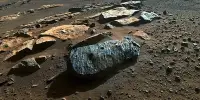Microbes extracted from surface sediment near Lost Hammer Spring, Canada, about 900 kilometers south of the North Pole, could provide a blueprint for the types of life forms that once existed, or may still exist, on Mars.
The extremely salty, very cold, and almost oxygen-free environment beneath the permafrost of Lost Hammer Spring in Canada’s High Arctic is the most similar to certain areas on Mars. So, if you want to learn more about the kinds of life forms that may have existed – or may still exist – on Mars, this is a good place to start. McGill University researchers discovered previously unknown microbes after much searching under extremely difficult conditions. Moreover, by using state-of-the-art genomic techniques, they have gained insight into their metabolisms.
In a recent paper published in ISME, the scientists show for the first time that microbial communities found in Canada’s High Arctic, in conditions similar to those on Mars, can survive by eating and breathing simple inorganic compounds of the type found on Mars (such as methane, sulfide, sulfate, carbon monoxide, and carbon dioxide). This discovery is so compelling that the European Space Agency chose samples of the Lost Hammer surface sediments to test the life detection capabilities of the instruments that will be used on the next ExoMars mission.
The microbes we discovered and described at Lost Hammer Spring are surprising because, unlike other microorganisms, they do not require organic matter or oxygen to survive.
Elisse Magnuson
Developing a blueprint for life on Mars
One of the coldest and saltiest terrestrial springs discovered to date is Lost Hammer Spring in Nunavut, Canada’s High Arctic. The water that rises through 600 metres of permafrost to the surface is extremely salty (~24 percent salinity), perpetually cold (~ – 5 °C), and contains almost no oxygen (1ppm dissolved oxygen). The extremely high salt concentrations keep the Lost Hammer spring from freezing, allowing it to maintain a liquid water habitat even in sub-zero temperatures.
These conditions are similar to those found on Mars, where widespread salt deposits and possibly cold salt springs have been discovered. While previous studies have discovered evidence of microbes in this type of Mars-like environment, this is one of the few studies to discover microbes that are alive and active.
A McGill University research team led by Lyle Whyte of the Department of Natural Resource Sciences used state-of-the-art genomic tools and single cell microbiology methods to identify and characterize a novel, and more importantly, an active microbial community in this unique spring to gain insight into the types of life forms that could exist on Mars. It was not easy to find the microbes and then sequence their DNA and mRNA.

It takes an unusual life form to survive in difficult conditions
“It took a couple of years of working with the sediment before we were able to successfully detect active microbial communities,” explains Elisse Magnuson, a PhD student in Whyte’s lab, and the first author on the paper. “The saltiness of the environment interferes with both the extraction and the sequencing of the microbes, so when we were able to find evidence of active microbial communities, it was a very satisfying experience.”
The researchers isolated and sequenced DNA from the spring community, allowing them to reconstruct genomes from approximately 110 microorganisms, the majority of which were previously unknown. These genomes have enabled the team to determine how such creatures survive and thrive in this one-of-a-kind extreme environment, and they have served as blueprints for potential life forms in similar environments. The team was able to identify active genes in the genomes and thus identify some very unusual microbes actively metabolizing in the extreme spring environment using mRNA sequencing.
No need for organic material to support life
“The microbes we discovered and described at Lost Hammer Spring are surprising because, unlike other microorganisms, they do not require organic matter or oxygen to survive,” Whyte continues. “Instead, they survive by eating and breathing simple inorganic compounds found on Mars, such as methane, sulfides, sulfate, carbon monoxide, and carbon dioxide. They can also fix carbon dioxide and nitrogen gasses in the atmosphere, making them well-suited to surviving and thriving in the most extreme environments on Earth and beyond.”
The next step in the research will be to culture and characterize the most abundant and active members of this strange microbial ecosystem in order to better understand why and how they are thriving in the very cold, salty muck of the Lost Hammer Spring. The researchers hope that this will aid in the interpretation of the intriguing but enigmatic sulfur and carbon isotopes recently obtained by the NASA Curiosity Rover in Mars’ Gale Crater.
















